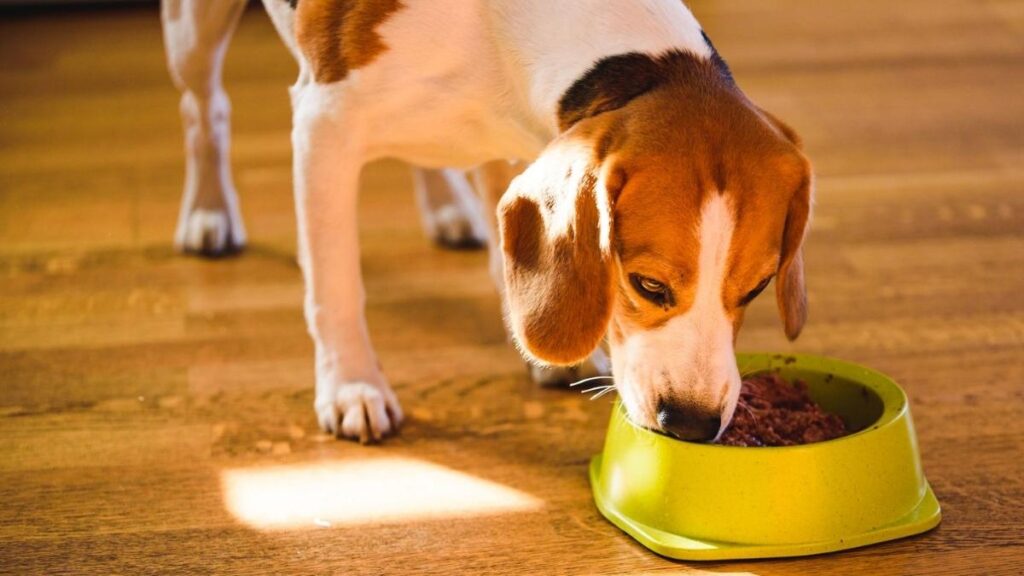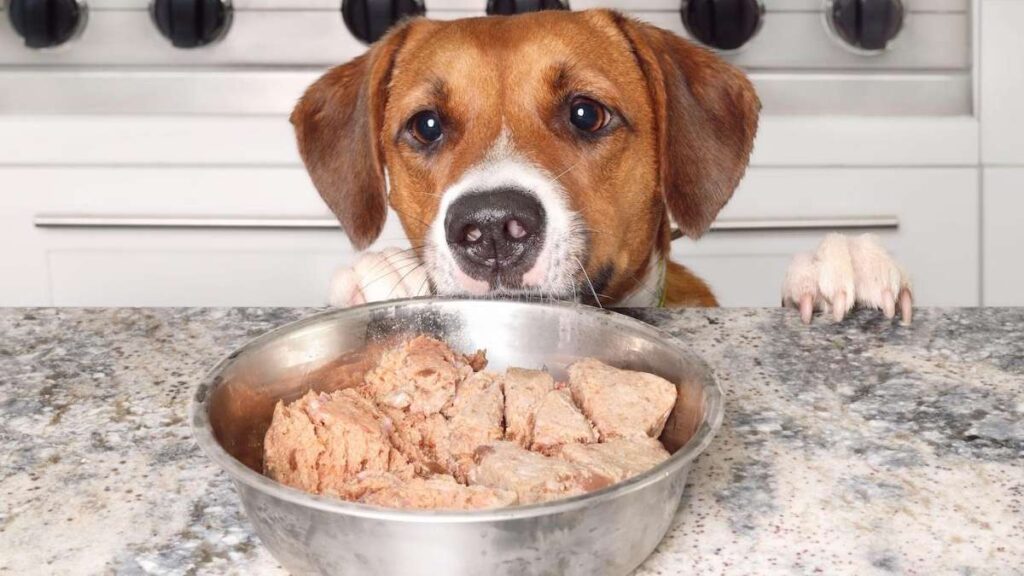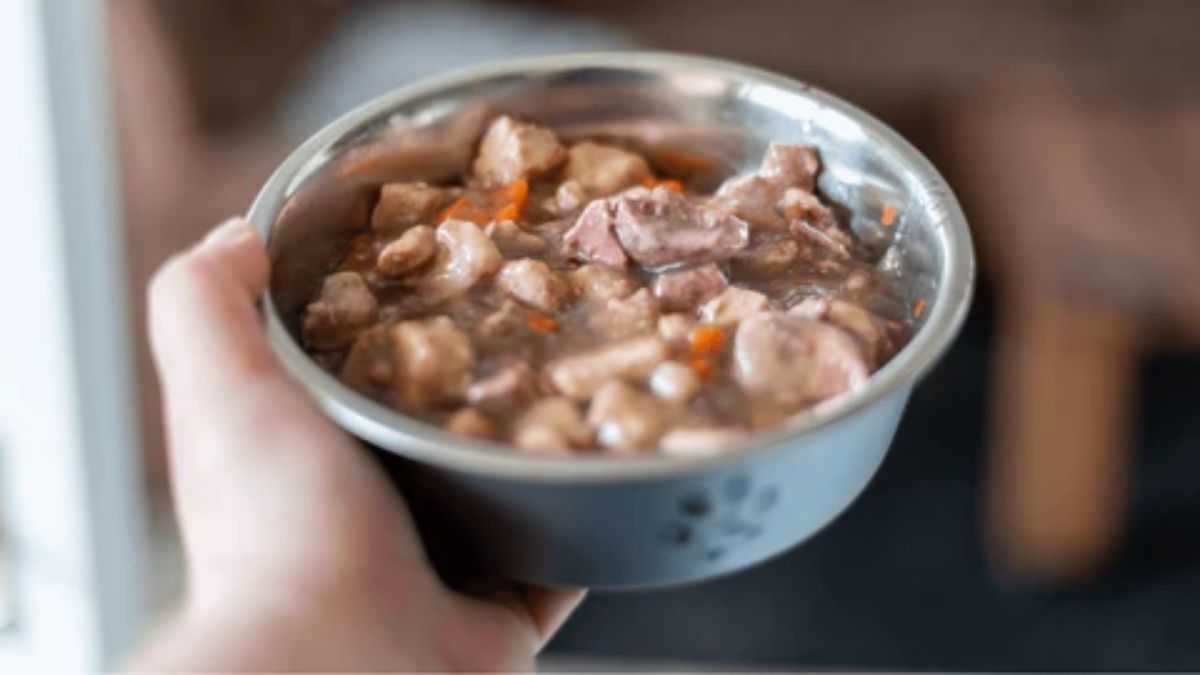How Much Wet Food to Feed a Dog for Optimal Health
According to the Association for Pet Obesity Prevention, 59% of dogs are overweight or obese, highlighting how crucial it is to know how much wet food to feed a dog. Many pet parents make the common mistake of assuming one can equal one serving, which can lead to serious health complications.
In fact, determining how much wet food to feed a dog depends primarily on their weight, with guidelines typically recommending one can per 15 pounds of body weight daily. However, these portions can vary significantly – while a 7-pound dog needs only half a can, a 90-pound dog requires six cans per day.
Wondering how much wet dog food your pup needs? This easy guide shows you exactly how to portion their meals based on their age, size, and energy levels, so they stay happy and healthy at every stage of life!
Contents
- 1 Understanding Your Dog’s Wet Food Needs
- 2 Basic Wet Food Feeding Guidelines
- 3 Creating a Daily Wet Food Schedule
- 4 Mixing Wet and Dry Food
- 5 Signs Your Dog’s Wet Food Portions Need Adjustment
- 6 How Much Wet Food To Feed A Dog Frequently Asked Questions
- 6.1 Can I mix wet and dry food for my dog?
- 6.2 How do I know if I’m feeding my dog the right amount of wet food?
- 6.3 How much wet food to feed a dog calculator?
- 6.4 How much wet food to feed a dog per day chart?
- 6.5 How much wet food to feed a dog calculator by weight?
- 6.6 How much wet food to feed a dog calculator by age?
Understanding Your Dog’s Wet Food Needs
Determining how much wet food to feed a dog starts with understanding several key factors that influence portion sizes. Primarily, a dog’s weight serves as the baseline for calculating portions, with feeding guidelines typically suggesting specific amounts per pound of body weight.
Factors affecting how much wet food to feed
A dog’s age plays a crucial role in determining how much wet food to feed a dog. Puppies need more protein and calories for growth, adult dogs require maintenance portions, and senior dogs often need adjusted amounts as their metabolism slows. Additionally, activity level directly impacts portion sizes – dogs with high exercise levels need more food than less active ones.
Reproductive status notably affects portions – spayed and neutered dogs typically need fewer calories than unaltered dogs. Furthermore, dogs with specific health conditions may require customized portions. For instance, diabetic dogs or those with kidney issues often benefit from moisture-rich wet food diets.
Benefits of wet food in your dog’s diet
Wet dog food offers several distinct advantages that make it an excellent choice for many dogs:
- Higher moisture content supports hydration, particularly beneficial for dogs who don’t drink enough water
- Enhanced palatability makes meals more appealing, especially for picky eaters
- Easier to chew, making it ideal for senior dogs or those with dental issues
- Generally contains more protein and less carbohydrates compared to dry food
Consequently, wet food can help with weight management since it creates a longer-lasting feeling of fullness. The higher protein content and lower carbohydrate levels may help prevent weight gain, particularly important since many dogs struggle with maintaining healthy weight.
Understanding how much wet food to feed a dog also involves recognizing that premium wet foods often contain higher-quality protein sources and fewer fillers. This means portions might be smaller than with budget options, as the food is more nutrient-dense. For optimal results, portions should be adjusted based on regular monitoring of your dog’s weight and energy levels.
Basic Wet Food Feeding Guidelines

Establishing proper portion sizes forms the foundation of a healthy feeding routine when determining how much wet food to feed a dog. A systematic approach based on specific factors ensures optimal nutrition for every canine companion.
Calculating portions by weight
The most reliable method to determine how much wet food to feed a dog starts with weight-based calculations. For standard wet food portions, feed approximately one 13-ounce can per 13-15 pounds of body weight daily. Subsequently, these basic measurements can be adjusted:
- Small dogs (2-12 lbs): ½ to 1 can daily
- Medium dogs (23-55 lbs): 2 to 4 cans daily
- Large dogs (56-88 lbs): 4 to 6 cans daily
Adjusting portions by age
Primarily, age-specific requirements dictate how much food should my dog eat. Puppies need more frequent meals throughout the day, specifically 3-5 meals for optimal growth. Adult dogs typically thrive on two meals daily, whereas senior dogs often benefit from smaller, more frequent portions.
Moreover, senior dogs require 20-30% fewer calories as their metabolism slows down. For working or highly active dogs, portions should be increased based on energy expenditure and regular body condition monitoring.
How much food should my dog eat daily
When determining how much to feed a puppy or adult dog, divide the total daily portion into multiple meals. For optimal digestion and energy levels, consider these feeding frequencies:
- Large/giant breeds:
- Adults: 2-3 meals daily
- Puppies up to 4 months: 3 meals daily
- Small/medium breeds:
- Adults: 2 meals daily
- Puppies up to 4 months: 3 meals daily
Specifically, when mixing wet and dry food, subtract ⅓ cup of kibble for every half can of wet food added. This adjustment prevents overfeeding while maintaining proper nutrition levels.
Regular monitoring remains essential – a dog’s nutritional needs can vary by up to 50% from standard recommendations. Watch for signs of proper portion sizing through weight maintenance, energy levels, and overall condition. Remember that how much should i feed my dog depends on maintaining consistent feeding times, which supports digestion and helps establish healthy eating patterns.
Creating a Daily Wet Food Schedule
Creating a consistent feeding schedule helps dogs thrive through predictable mealtimes. Understanding how much wet food to feed a dog becomes more effective when paired with proper timing and frequency.
Morning vs evening feeding
Establishing regular feeding times helps with digestion and behavior management. Dogs should receive their wet food portions at 8-12 hour intervals. Primarily, this timing allows proper digestion between meals and prevents stomach hyperacidity, which can cause nausea if more than 12 hours pass between feedings.
A dog’s simple stomach anatomy means food moves into the small intestine within hours after eating. Therefore, spreading meals throughout the day supports better nutrient absorption and helps determine how much wet food to feed a dog for optimal health.
Single vs multiple meals
The number of daily meals varies based on age and size:
- Large and giant breeds:
- Adults: 2-3 meals daily
- Puppies up to 4 months: 3 meals daily
- Small and medium breeds:
- Adults: 2 meals daily
- Puppies up to 4 months: 3 meals daily
- Toy breeds:
- Adults: 2 meals daily
- Puppies up to 4 months: 4-5 meals daily
- Puppies 4-6 months: 3 meals daily
When determining how much should my dog eat, remember that puppies typically need more frequent feedings to support their rapid growth. Alternatively, adult dogs generally maintain stable energy levels with two daily meals.
For optimal results, each feeding should last approximately 20 minutes. If food remains uneaten after this time, remove it until the next scheduled meal. This approach helps establish healthy eating patterns and makes it easier to track how much food should i feed my dog.
A puppy feeding chart suggests that dogs under three months need four daily meals, while those between 3-6 months can transition to three meals. As dogs mature, their feeding frequency naturally decreases, though small breeds may benefit from maintaining three daily meals to prevent hypoglycemia.
Regular mealtimes create security and predictability, particularly helpful during household changes or when determining how much to feed a puppy in new environments. Nevertheless, consistency in timing proves just as crucial as portion control for maintaining healthy weight and energy levels.
Mixing Wet and Dry Food
Combining wet and dry dog food offers unique advantages for determining how much wet food to feed a dog. The practice provides both nutritional variety and cost-effectiveness, making it an increasingly popular choice among pet owners.
Proper ratios for different sizes
Understanding how much wet food to feed a dog in combination with dry food requires careful calculation. The standard recommendation suggests dry food should make up 75% of the meal’s total weight, with wet food comprising the remaining 25%. Indeed, this ratio provides an optimal balance of nutrition and hydration.
For precise portions, start by calculating the daily recommended amount of dry food. Primarily, wet food contains fewer calories per gram than dry food, making straight substitutions impractical. A practical approach involves reducing ⅓ cup of kibble for every half can of wet food added to maintain proper caloric intake.
Alternatively, pet parents can adjust ratios based on their dog’s needs:
- 50/50 split: Equal parts wet and dry food
- 75/25 split: Three-quarters dry food with one-quarter wet food
- 25/75 split: One-quarter dry food with three-quarters wet food
Transitioning between foods
When determining how much wet food to feed a dog in a mixed diet, undoubtedly the transition period proves crucial for digestive health. A gradual seven-day transition helps prevent stomach upset. The recommended timeline follows this pattern:
- Day 1-2: 75% current food, 25% new mixed diet
- Day 3-4: 50% current food, 50% new mixed diet
- Day 5-6: 25% current food, 75% new mixed diet
- Day 7: 100% new mixed diet
Dogs with sensitive stomachs might need an extended transition period. Throughout this process, monitor your pet’s response carefully – any signs of digestive upset indicate a need to slow the transition pace.
One distinctive advantage of mixed feeding lies in its flexibility. Pet parents can serve wet and dry portions separately rather than combining them in one bowl. This approach proves particularly beneficial as dry food maintains freshness longer, while wet food portions can be served at optimal times for maximum palatability.
Remember that how much food should my dog eat varies based on individual factors. Regular monitoring of weight, energy levels, and stool consistency helps fine-tune portions. For optimal results, maintain consistent feeding times and adjust ratios based on your dog’s specific needs and preferences.
Signs Your Dog’s Wet Food Portions Need Adjustment

Regular monitoring helps pet parents determine how much wet food to feed a dog by watching for specific health indicators. As a veterinarian with extensive experience in canine nutrition, I’ve observed these key signs that suggest portion adjustments are needed.
Weight changes
Monitoring weight serves as the primary indicator when determining how much wet food to feed a dog. The Association for Pet Obesity Prevention reports that 59% of dogs are overweight or obese. Pet parents should check their dog’s body condition regularly – a healthy dog should have a visible waist from above, and ribs should be easily felt but not seen.
For accurate tracking, weigh your dog monthly or during routine vet visits. A consistent trend in weight changes matters more than occasional fluctuations. Basically, if you need to press hard to feel your dog’s ribs, the portions likely need reduction.
Energy levels
Changes in energy patterns often signal that adjustments are needed when deciding how much food should my dog eat. Dogs receiving too much food typically show decreased interest in activities they previously enjoyed. Alternatively, underfed dogs might display:
- Excessive hunger before meals
- Reduced enthusiasm for exercise
- General lethargy or weakness
- Decreased interest in play
Initially, overfeeding can lead to digestive discomfort, causing sluggishness and appetite fluctuations. Similarly, underfed dogs might lack the energy for normal activities, primarily noticeable in younger dogs.
Stool consistency
Stool quality essentially serves as a window into digestive health when determining how much should I feed my dog. A puppy feeding chart should consider that overfeeding often results in softer stools later in the day. The Bristol Stool Form Scale classifies healthy stools as:
- Type 3-4: Sausage-shaped with slight cracks to smooth surface
- Type 1-2: Too hard, indicating potential underfeeding
- Type 6-7: Too soft, suggesting possible overfeeding
Soon after implementing portion changes, monitor stool consistency carefully. Regular, soft, and brown bowel movements indicate good digestive health. Primarily, watch for patterns where stools start normal in the morning but become progressively softer throughout the day, as this often signals portion sizes need adjustment.
When determining how much to feed a puppy or adult dog, remember that stool consistency strongly relates to transit time and defecation frequency. Irregular bowel movements, whether too frequent or infrequent, can indicate how much should my dog eat and need adjustment. Proper portion sizes typically result in consistent, well-formed stools throughout the day.
How Much Wet Food To Feed A Dog Frequently Asked Questions
Can I mix wet and dry food for my dog?
Yes, mixing wet and dry food can be beneficial. A common approach is to use 75% dry food and 25% wet food by weight. When mixing, reduce 1/3 cup of kibble for every half can of wet food added to maintain proper caloric intake. Always transition to a new diet gradually over about a week to prevent digestive upset.
How do I know if I’m feeding my dog the right amount of wet food?
Monitor your dog’s weight, energy levels, and stool consistency regularly. A healthy dog should have a visible waist from above, and you should be able to feel their ribs easily but not see them. If you notice significant weight changes, decreased energy, or consistent stool issues, it may be time to adjust your dog’s portion sizes.
How much wet food to feed a dog calculator?
To determine how much wet food to feed a dog, you can use an online calculator that takes into account the dog’s weight, age, and activity level. These calculators typically suggest a daily portion size in grams or cups, which helps ensure your dog gets the right balance of calories and nutrients. However, it’s important to consider your dog’s specific needs, such as whether they have any health conditions or if they’re particularly active or sedentary. Always adjust portions based on your dog’s unique circumstances for optimal health.
How much wet food to feed a dog per day chart?
A “how much wet food to feed a dog per day chart” provides recommended portions based on the dog’s weight, usually broken down by specific weight ranges (e.g., under 10 lbs, 10-20 lbs, etc.). This chart can help you quickly identify how much food your dog needs without having to use a complex calculator. Keep in mind that these charts are general guidelines and may need to be modified depending on your dog’s breed, metabolism, and any special dietary needs. Consulting with your vet can also ensure the most accurate feeding plan.
How much wet food to feed a dog calculator by weight?
A wet food calculator by weight calculates the amount of food your dog should be eating based on their current weight. Generally, larger dogs need more food, while smaller dogs require less. These calculators ensure that your dog is getting the appropriate portion size based on their weight to maintain a healthy body condition. It’s important to note that factors such as activity level, age, and health conditions should also be factored into the calculations for more precise recommendations.
How much wet food to feed a dog calculator by age?
A wet food calculator by age helps determine the appropriate feeding portions based on the dog’s life stage, such as puppy, adult, or senior. Puppies typically require more food and higher portions due to their growth rate, while adult dogs need a balanced portion to maintain a healthy weight. Senior dogs may need smaller servings, particularly if their activity level has decreased or if they have health issues that require a controlled diet. Adjusting food portions according to age ensures that your dog receives the right nutrients at each stage of their life.

